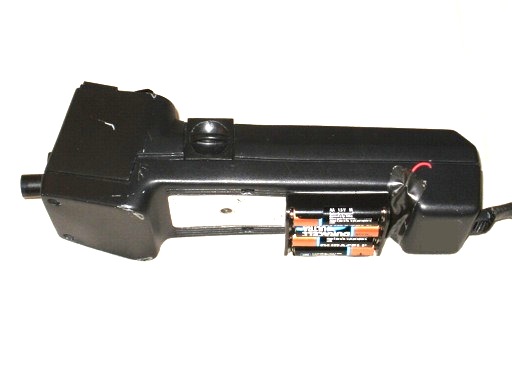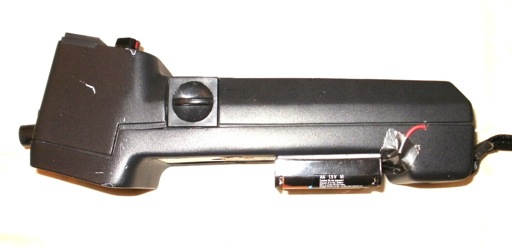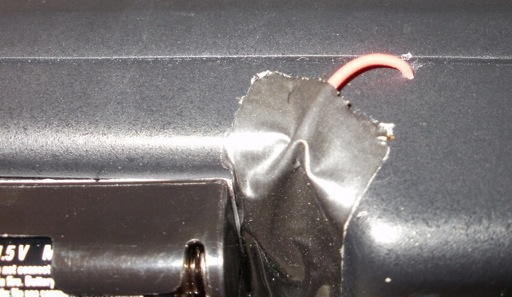
Figure 1. External Battery Pack Mounted on the Underside of the Mini-Zap
Abstract: Sometimes
a quick solution is needed to an engineering test problem. Details are
shown of a quick modification to a KeyTek Mini-Zap ESD Simulator to
power it from four AA batteries.
Discussion: The KeyTek MZ-15 ESD Simulator
that I have used in many of the experiments on this website and in
countless seminars is powered from internal Ni-Cd AA batteries of about
700 mAh capacity. The machine is not in daily use and the result is
that the batteries go bad in a few years and will no longer hold a
charge, necessitating a trip back to the factory. Also, in the case of
many ESD simulators, if the battery is dead and the charger is not
available immediately or there is no mains power available, an ESD test
may have to be postponed.
To solve the problem of the bad Ni-Cd battery pack in my case, I carefully removed the (leaking) Ni-Cd batteries from the small plug-in circuit board they were soldered to. I used vinyl gloves and a covered work area as the chemicals in Ni-Cd batteries (especially the cadmium) are toxic to humans. Next, I mounted a high quality four AA battery holder on the bottom of the Mini-Zap as shown in Figure 1 using double stick tape such as used to mount pictures or secure a carpet to the floor underneath. Very small "V" grooves on opposite sides of the Mini-Zap housing were made to feed the battery wires into the unit and the battery wires were soldered to the small plug-in board that originally held the Ni-Cd batteries. I was careful to connect the "+" wire in such a way as to preserve the function of the small fuse on the original battery board.
A side view of the completed modification is shown in Figure2 with a close-up of the positive battery wire entering the side of the Mini-Zap housing shown in Figure 3.


Figure 3. Close-up View of Battery Connection
The capacity of a good set of Ni-MH batteries or AA alkaline batteries is on the order of 2.5 to 3.0 Ah (Ampere-hours) when discharged over several hours so a set of alkaline AA batteries should last for many hours of use. In my case, the Mini-Zap will go weeks between uses so I just put in a set of AA alkaline batteries when I am ready to test.
Cautions: If you are using a Mini-Zap for calibrated EMC compliance testing, the calibration of the Mini-Zap should be checked after modification. The modified unit works perfectly off of the AA batteries for my purposes though. Also, do not make this modification if your simulator is still under factory or other warrantee.
To solve the problem of the bad Ni-Cd battery pack in my case, I carefully removed the (leaking) Ni-Cd batteries from the small plug-in circuit board they were soldered to. I used vinyl gloves and a covered work area as the chemicals in Ni-Cd batteries (especially the cadmium) are toxic to humans. Next, I mounted a high quality four AA battery holder on the bottom of the Mini-Zap as shown in Figure 1 using double stick tape such as used to mount pictures or secure a carpet to the floor underneath. Very small "V" grooves on opposite sides of the Mini-Zap housing were made to feed the battery wires into the unit and the battery wires were soldered to the small plug-in board that originally held the Ni-Cd batteries. I was careful to connect the "+" wire in such a way as to preserve the function of the small fuse on the original battery board.
A side view of the completed modification is shown in Figure2 with a close-up of the positive battery wire entering the side of the Mini-Zap housing shown in Figure 3.

Figure 2. Side View of External Battery Modification

Figure 3. Close-up View of Battery Connection
The capacity of a good set of Ni-MH batteries or AA alkaline batteries is on the order of 2.5 to 3.0 Ah (Ampere-hours) when discharged over several hours so a set of alkaline AA batteries should last for many hours of use. In my case, the Mini-Zap will go weeks between uses so I just put in a set of AA alkaline batteries when I am ready to test.
Cautions: If you are using a Mini-Zap for calibrated EMC compliance testing, the calibration of the Mini-Zap should be checked after modification. The modified unit works perfectly off of the AA batteries for my purposes though. Also, do not make this modification if your simulator is still under factory or other warrantee.
Summary: A simple modification of a KeyTek ESD simulator is described that will power the unit from four AA alkaline or Ni-MH batteries.
Equipment used in this article is:
Need help with a design or additional training on technical subjects? Click on the image below to go to CircuitAdvisor.com, a new engineering resource for training, news, and fun.
If you like the information in this article and others on this website,
much more information is available in my courses. Click here
to see a listing of upcoming courses on design, measurement, and
troubleshooting of chips, circuits, and systems. Click here to see upcoming seminars in Newport Beach, CA.
Click here for a description of my latest seminar titled (now also available online as a WebEx seminar):
EMC
Lab Techniques for Designers
(How to find EMC problems and have some confidence your system will pass EMC testing while it is still in your lab).
(How to find EMC problems and have some confidence your system will pass EMC testing while it is still in your lab).
Home

